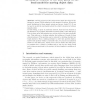Free Online Productivity Tools
i2Speak
i2Symbol
i2OCR
iTex2Img
iWeb2Print
iWeb2Shot
i2Type
iPdf2Split
iPdf2Merge
i2Bopomofo
i2Arabic
i2Style
i2Image
i2PDF
iLatex2Rtf
Sci2ools
DAGSTUHL
2007
2007
An analytic solution to the alibi query in the bead model for moving object data
Abstract. Moving objects produce trajectories, which are stored in databases by means of finite samples of time-stamped locations. When also speed limitations in these sample points are known, beads [1, 6, 9] can be used to model the uncertainty about the object’s location in between sample points. In this setting, a query of particular interest, that has been studied in the literature of geographic information systems (GIS), is the alibi query. This boolean query asks whether two moving objects can have physically met. This adds up to deciding whether the necklaces of beads of these objects intersect. This problem can be reduced to deciding whether two beads intersect. Since, existing software to solve this problem fails to answer this question within a reasonable time, we propose an analytical solution to the alibi query, which can be used to answer the alibi query in constant time, a matter of milliseconds or less, for two single beads and in time proportional to the product of t...
| Added | 29 Oct 2010 |
| Updated | 29 Oct 2010 |
| Type | Conference |
| Year | 2007 |
| Where | DAGSTUHL |
| Authors | Bart Kuijpers, Walied Othman |
Comments (0)

